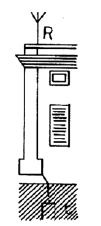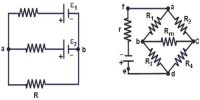In order to protect buildings from the ravage of lightning, the lightning conductor is used. The metallic rod R (Fig) with several sharp points at the top is fixed in such a way that its upper end extends several feet above the roof of the building and lowers end runs down along the outer surface of the building and buried well inside the moist earth.

When a charged cloud passes above the building then the charge of opposite kind is induced in the conductor rod R The accumulation of charge is at the maximum at the pointed ends of the lightning conductor and pointed ends discharges their charge to the air particles around it. The air particles around the sharp points are charged by conduction and are attracted by the opposite charges of cloud and moves towards the cloud is neutralized. As a result, the probability of thunderbolt decreases.
Electricity always passes following the shortest path through a conductor. The charge produced in the clouds tends to reach the earth through the high standing objects. During storm and rain, it is rather good to wet in the rain than to stand under an umbrella, any tree, near any conductor, iron bridge or fence of sharp iron wire.











